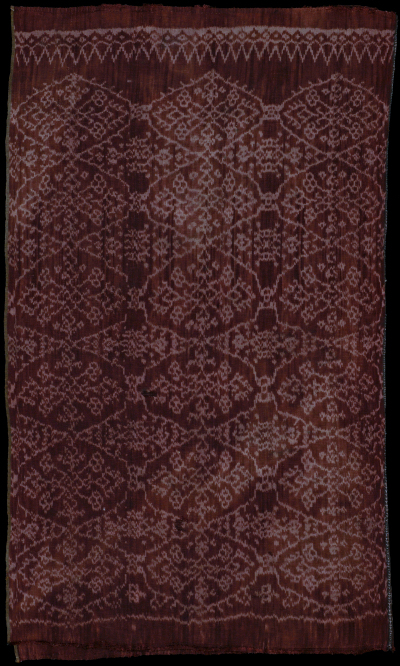| |
 
 | | | |
024 Flores Group, Sikka
Sarong  
| | Locale: | Identification of Sikka provenance is tentative. Another possibility is the area in Ende Regency north of Lio called Detusoko. | | Period: | 1925 or older | | Yarn: | Cotton, hand-spun, fine | | Technique: | Warp ikat | | Panels: | 2 | | Size: | 70.5 x 120.5 cm (2' 3" x 3' 11") LW: 1.71 | | Weight: | 555 g (19.6 oz), 327 g/m2 (1.07 oz/ft2) | | Design: | Nearly entire field decorated with patola-inspired pattern, imitating jilamprang motif. Border with tumpal motif. Unusual in that the piece consists of only two panels. Overall design, which deviates from the banded structure common in the Sikka region, makes an archaic impression, as if it dates from a period before formalisation of design standards. Unusual is also the weave type: twin warp interlacing with triple weft. Other than in this cloth, this weave type was only encountered a few times in Sarawak - nowhere else in the Indonesian archipelago. | | Comment: | Sarong (opened, only one of two panels shown) in very fine hand spun yarn from the beginning of the 20th C. or before. Good overall condition, slightly soiled, with two small holes due to wear. Size given above reflects size when sewn into a tube skirt. The intricate jilamprang motif is well executed, showing the hand of an able weaver. Triple weft was used, presumably to give the cloth more body, producing a surface with slight ribbing. As the cloth was executed in morinda red only, in all likelihood it was made as bridewealth. | | Background: | Chapters on Flores Group and Sikka. | | Sources: | No true cognate known from literature. Similar patterning on Sikka sarong in Fowler Museum, UCLA FMCH X95.48.4, though here it does not cover the entire field, just the main ikated band. Similar patterning, though less evolved, on the midfield of Ngadha sarong in Nr. UCLA FMCH X88.1284. | | |

©Peter ten Hoopen, 2024
All rights reserved.
|
|


